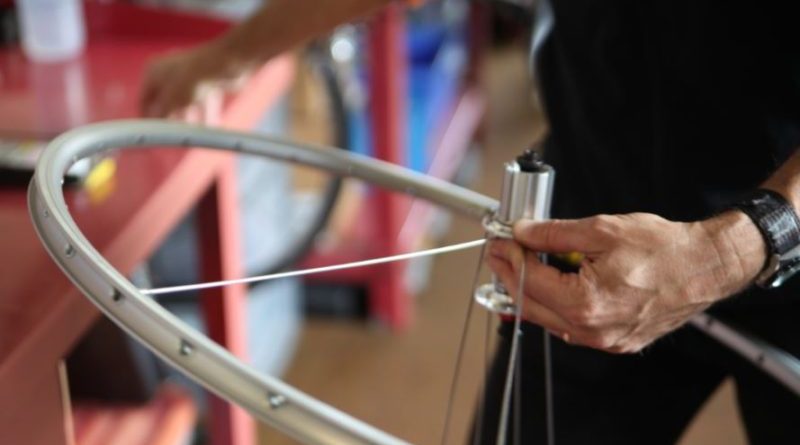Repair Shop #2: “But we’ve always done it like that” and other phrases worth ditching
 Sales training expert Colin Rees’ has some fresh new ideas for bike shops to boost profits through the workshop, in this second of three focused articles on repair shops…
Sales training expert Colin Rees’ has some fresh new ideas for bike shops to boost profits through the workshop, in this second of three focused articles on repair shops…
Last issue, I promised owners a revelation in changes that can be made to running their store, focusing on the repair shop as a profit centre, as opposed to some attitudes I have seen from owners, who look on the workshop as just a place customers expect you to have. This series – of which this is the penultimate article has been making the case for creating the best bike shop experience in your district; one where customers are a hard core of people who just wouldn’t go anywhere else and in the last issue in the series next time, we will be summarising how to do that.
In the meantime, it seems sensible to look carefully at the area where the internet has literally no chance, the workshop. If selling bikes is becoming increasingly difficult, vastly improving your sales performance is a must, we have covered that, but so is concentrating on the profit centre largely seen as second best, to replace the missing income.
As I mentioned in previous articles, it is critical to take a long hard look at your people because as usual, they are the key to your future, not just chaps there to get the work out. You would expect me to centre on training and as I mentioned last time, training is the key to sales increases, given you leave everything as it is now, so looking carefully at your mechanics first becomes the sensible starting point. Mechanics first and foremost must be able to fix bikes, that’s a given. But do they fix bikes profitably? Are they careful with stock and parts? Do they waste materials? Are they time efficient? What is their productivity like? Are your maintenance packages fully costed regularly? Have you recently worked with them for a day here and there, to see what actually happens and where savings can be made?
I mentioned last time, they are a hidden sales force in some stores where they are ‘never let out’ and actually are often most happy not coming out at all. Not good. They only need basic sales skills to be successful and that means training. The main thing they need is conviviality and confidence, which are both trainable. Often described as ‘nice people’, they need to be able to hold a conversation, watching for buying signals, taking a customer down a road to lead to a lasting relationship.
On the course when mechanics are present, I like to shock them by saying they have the propensity to be the most boring people on the planet. When a customer asks a technical question, they just want to know the answer, not the finite detail a mechanic is able to give, down to the name of the person who welded the frame and his grandmother’s shoe size. Given the correct properly trained team, the new workshop profit centre is ready to go.
However, an element of planning, we have already said, is innovation and lots of other things will happen when you relocate the whole repair area to be visible and put customers in touch with vast, technical knowledge, your greatest staff asset. The internet will never be capable of a face-to-face discussion with someone technical, properly trained to answer and help customers who then will not go anywhere else.
In past articles, we visited the idea of examining how your particular market would respond to professional sales people selling your bikes and accessories, as opposed to the traditional way in our industry of recruiting ‘bikey types’ who are cheerful and hoping that works. Having brought technical know-how into predominance, it is readily available to sales people as well as customers. This means, sales people no longer need to know as much and this opens the door to another revolution.
Staffing the sales team with people who understand selling as their main skill and are trained in just the aspects of bike technology they need to have to do the best job, is then an accessible option. Sales have to rise? You just do not need a high level of knowledge to sell a bike. What you do need is just enough because, a huge font of knowledge is on display, working away where they are accessible. Ah, is this something else the internet cannot match?
So, in summary, we have a visible workshop that welcomes customers gazing or browsing as it’s called, properly dressed professional looking mechanics, perhaps a new ‘type’ of sales person and a revamped store with accompanying marketing and press releases. In essence, a team of people setting out to give customers the very best bike shop experience they can get, who just would not go anywhere else. But something is missing. What did it actually cost the business to get to this point? Such alterations might well take some budget but in essence, surely, all that is actually happening is a move round, a clean up and some strategic placing of tools and equipment?
In the main, the time and effort comes free and the business is paying for that anyway. It will not cost mountains of profits and it is life changing for the business. It is well known in retailing that upgrading or changing a retail space sparks great interest and usually leads to a lift in sales levels, in any event. So this said, you get the investment back, week after week after week.
Perhaps it’s worth mentioning that accepting change of any sort is often mentally resisted. If you want to take elements of the suggestion, perhaps putting bike building in the middle of store and keeping muck and bullets in the back, hallelujah. The customers will still be getting all the benefits of seeing the workshop process and what is it they say about a picture being worth a thousand words?
Let’s talk about making cash. What can we do with our new area? How do we start making instant revenue? Well, it is so easy when you start having very simple ideas after reviewing how, and why, you do things the way you do. One simple idea will increase your net profit overnight if you spend this evening thinking about how your business receives repairs. Some shops say everyone takes bikes in for repair which means, no one specialises. Let me explain…
A training course always includes loads of simple, often hugely profitable ideas. Here’s how we convince staff to change their attitudes and it works best when the boss sits in. As I go around stores all over the UK and Ireland giving training sessions, towards the end, I ask one of the mechanics to go and fetch out any repair bike waiting to be finished. He brings it out, we stand it up and look at it, identifying who took it in and swearing him to silence. We then discuss what sort of person rides this bike? How much riding has been done on the bike, we ask what repair the bike has come in for?
Invariably, as you would expect, they are spot on with their assumptions. There are two reasons for this exercise, the first being to show people that they may be employed as sales people, but everyone in the store is capable, efficiently to ‘receive’ any bike that comes in for repair. It is a confidence prelude to a technique that made one store in the Midlands, a sizeable lift in turnover and many more since.
The second objective is to play a game. Having correctly identified the rider, I ask, what accessories could be added to this bike that are not present. Believe it or believe it not, all over the UK, the average that every team comes up with, is five. That’s the average, so some are four and some are eight. For the purposes of this revelation, let us assume a very conservative estimate of what is achievable perhaps, three.
So, let’s do the math. How many repairs do you do in the course of a year, my next question to the team? Well, say five a day, times six days maybe, that’s 30 a week, times 50 weeks allowing for breaks, that’s 1,500 repairs.
Here’s the good bit. So, 1,500 repairs times three accessories per bike means that business is losing a potential 4,500 accessory sales every single year because all they have to do is point out to the customer those accessories can be fitted to the bike when it’s here, you will make no charge for the fitting and they will have a hugely better bike. How easy is that?
But the best bit is yet to come. At what cost? Nil. So, all the margin goes straight to net profit, the reason for you being in business in the first place and if your store is suffering from Internet buying, implement this today. Many shops I have trained have put this into practice. The one in the Midlands allocated the best sales person and a senior mechanic to work together to take in every repair, just them, and implement this strategy. Accessory sales went through the roof. Repair profits increased. What they call, a win-win team.
If you think that’s good, in the last article in the series, I will reveal the way any bike shop with a fully functioning workshop can implement a way to capture the repair market in their area for around £5… and some sales training. In today’s retail environment, it is time people dumped the phrase, “we’ve always done it like that” and started to think out of the box. It’s the way to bigger net profits.
Colin Rees
Retail Sales Trainer & Business Consultant.
w colinrees7.wordpress.com
e Colinrees7@gmail.com



